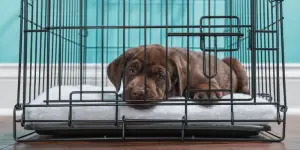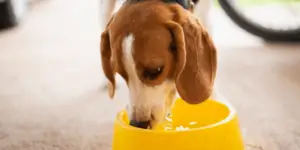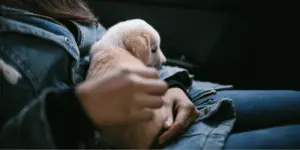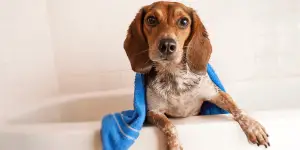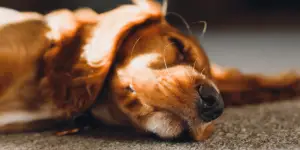
When can puppies get groomed for the first time?
- Written by Joshua Gordon
- Last updated
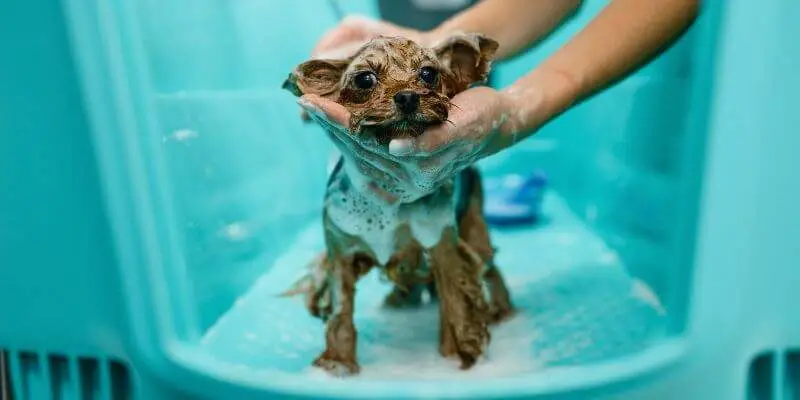
Key takeaways
- Start getting your puppy groomed at 10 to 12 weeks old. This will help your pup become accustomed to a grooming environment as young as possible.
- Make sure your puppy is fully vaccinated. Your puppy should have completed both rounds of their vaccinations before they are taken to a groomer.
- Get your puppy used to being groomed at home. This will make the trip to the groomer easier as your puppy will already be used to the experience.
- Go to the groomer regularly. Consistency is key, otherwise, your puppy will regress in training.
- Groom your puppy regularly at home. This is important for maintaining healthy nails, ears, and a shiny coat.
In this article
What age should I start getting my puppy groomed?
You should start getting your puppy groomed when they are between 10 weeks to 12 weeks old. It’s best to start young to get your pup used to the sensation of being groomed and promote good behavior in the long run.
Make sure your puppy has had both rounds of their vaccinations before you take them to the groomer.
Start early to build good behavior
The earlier you introduce your puppy to being groomed, the easier it will be to build good behavior in the long run. Like with most things in your puppy’s training, consistency and patience are key when it comes to grooming.
You should be getting your puppy used to being brushed, having their nails trimmed, and teeth and ears cleaned as soon as they’ve settled into their new home.
Eight weeks is the minimum age a puppy should leave their mother and siblings, so around this age is a good time to get your pup used to be groomed
In addition, it will make the eventual trip to the groomer far less scary and stressful for your puppy as it won’t be an entirely new experience for them.
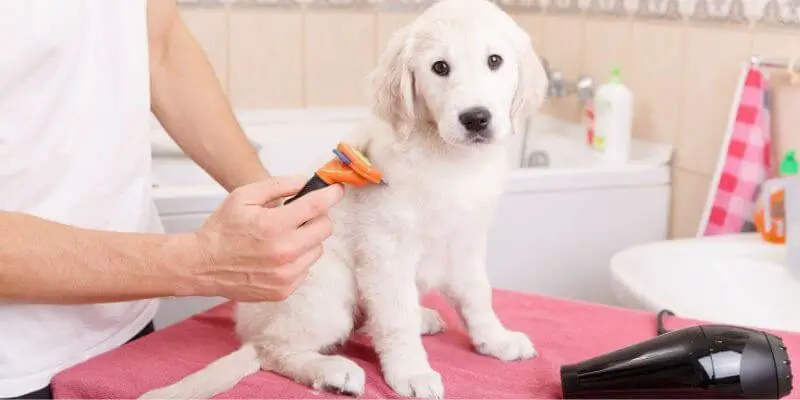
What puppies need to visit the groomer?
Most puppies can benefit from a trip to the groomer every now and again, but dogs with long-haired or double coats in particular will need frequent grooming sessions.
Breeds that require regular grooming include the poodle, husky, old English sheepdog, cocker spaniel, Afghan hound, Maltese, and Yorkshire terrier.
Puppies with high grooming needs such as those above should go to the groomers around every 10 to 12 weeks. You’ll still need to maintain your dog’s coat and nails yourself during this period.
If you haven’t done so already, it’s a good idea to learn how to trim your puppy’s nails. You should aim to cut your puppy’s nails once or twice a month.
Smooth and short-haired dogs such as the beagle, boxer, French bulldog, pug, beagle, and labrador retriever do not need to visit the groomers frequently.
However, it can still be a good idea to take them semi-regularly to have their nails trimmed, ears cleaned, and their anal glands emptied.
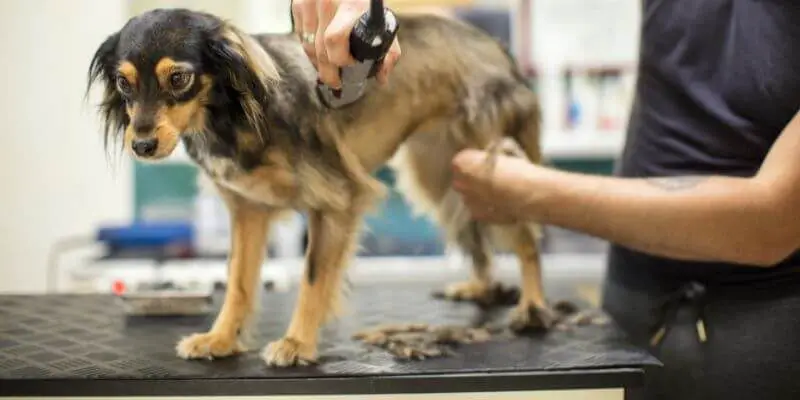
What to expect for the first grooming appointment
The first few grooming sessions for your puppy will likely be the most challenging, and they may be overwhelmed and scared. It will be stressful being in a brand-new setting with an unfamiliar person, but the more times your puppy is subjected to the experience, the easier it will become.
During the first appointment, your groomer will focus on getting your puppy relaxed around the grooming equipment like standing on the table and the sound of the clipper. They will also help your pooch get used to being handled by a new person.
The groomer will slowly introduce your dog to having their nails trimmed and ears cleaned so as not to rush your puppy.
Depending on how well your pup performs, the groomer may be able to go ahead and groom your puppy properly. However, it may take several sessions until your pooch is comfortable enough with the full process.
At 10 to 12 weeks of age, your puppy won’t need to have their coat trimmed as it will not be long or thick enough yet. Puppies usually begin to lose their puppy coats by around 4 to 6 months old, but it can take another 6 months for the adult coat to fully set in.
You should avoid cutting your puppy’s coat until they are at least 6 months of age as doing so can affect the quality of their primary hairs and cause a problematic adult coat. The primary hairs are responsible for protecting your pup’s skin from the elements, so they are very important.
Most trustworthy groomers will recommend 2 to 3 shorter sessions before moving on to a full-service groom. This will gently and slowly introduce your puppy to the experience without overwhelming them, which will make subsequent sessions easier.
If your puppy is nervous or frightened, you may need to stay with them during the initial few grooming trips until they are relaxed without you being there.
More confident puppies, on the other hand, may be completely fine with being groomed from the get-go. A lot of it depends on your puppy’s personality – every dog is different!
It’s important not to rush your puppy as you don’t want them to develop a negative association with the groomer. Patience is crucial.
After your puppy’s first grooming appointment, your groomer will likely create a grooming schedule based on your dog’s coat length and maintenance. Long-haired dogs or those with double coats generally need to visit the groomer every 10 to 12 weeks.
While short-haired dogs typically don’t need to be groomed as often, it’s still a good idea to take them to the groomer’s regularly for skin, nail, and anal gland check-ups.
Is grooming a puppy important?
Grooming a puppy is very important as it keeps their coat, ears, nails, and eyes healthy and in good shape. Both short-haired and long-haired puppies can benefit from regular grooming, both at home and by a professional dog groomer.
Brushing your puppy’s coat will help loosen off dirt and excess fur, as well as give you the chance to check their skin for bumps, sores, fleas, ticks, etc. Trimming your dog’s nails will prevent them from becoming overgrown and allow you to assess the health of their feet.
Cleaning your puppy’s ears will help remove wax and debris so they don’t get infected. Cleaning your puppy’s eyes will reduce irritation and prevent infections. And lastly, brushing your puppy’s teeth will prevent tartar buildup and dental issues.
Bear in mind that most groomers don’t offer teeth cleaning services. It’s up to you to keep your puppy’s teeth healthy with regular brushing and check-ups at the vet.
Final thoughts
So, to sum up: the best time to start introducing your puppy to the groomer is around 10 to 12 weeks old. The younger you start, the more well-behaved they will be in the long term.
It’s important to prepare your puppy before their first grooming appointment. Begin brushing your puppy’s coat, cutting their nails, and cleaning their eyes/ears as soon as they’ve had time to settle into their new home.
Doing so will help build up their confidence around being groomed and make the experience less stressful overall.
Make sure your puppy is fully vaccinated before you take them to the dog groomer. The first appointment should be slow and short to gently introduce your puppy to the world of grooming.
Bear in mind that some puppies will never enjoy being groomed, while some love being pampered. It’s important not to punish your dog if they are frightened or stressed as this will only heighten the emotion and lead to undesirable behavior.
References

Written by: Joshua Gordon
Head of Research and Editorial, Joshua has over 7 years of experience as a finance and automotive research consultant. He is a childhood pet owner and dog enthusiast.

